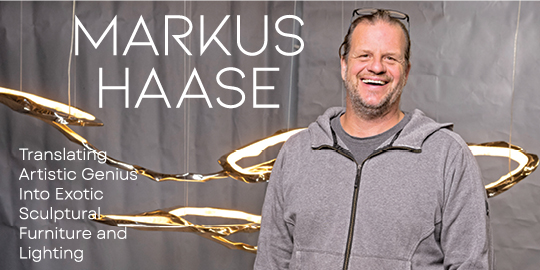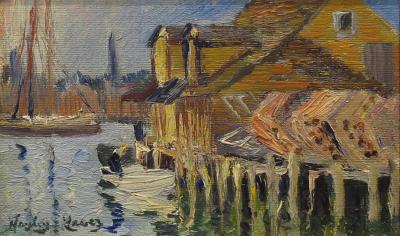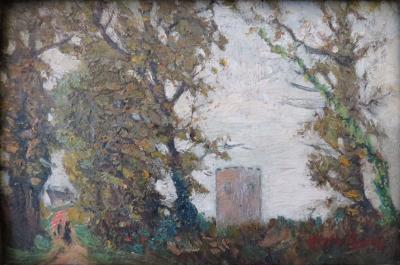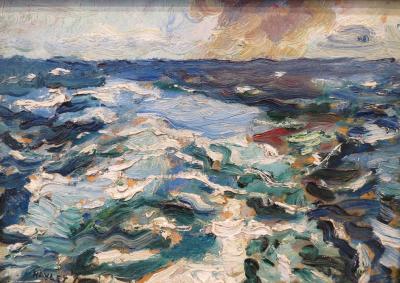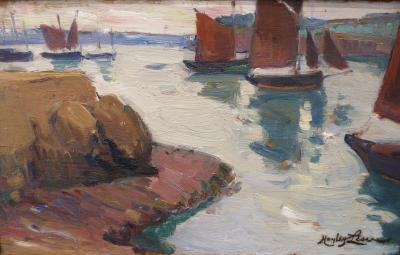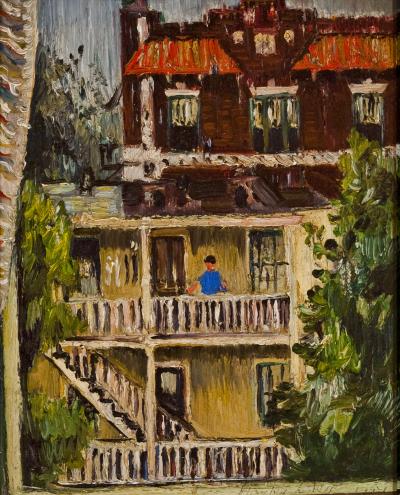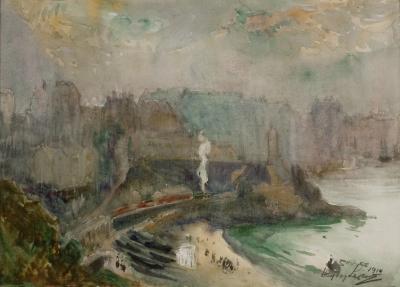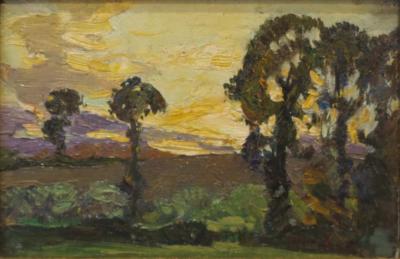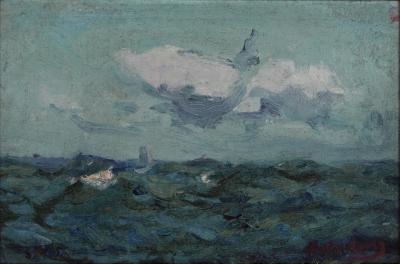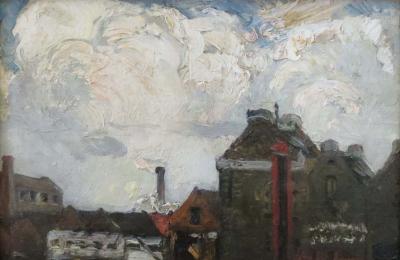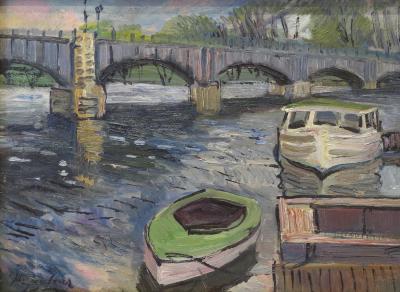Richard Hayley Lever
Australian, 1876 - 1958
Richard Hayley Lever Born, Australia, 1876 Died, 1958 Born in Adelaide, Australia, Richard Hayley Lever began studying art as a child. Around the turn of the century, Lever used his inheritance from his grandfather to fund a trip to study in Europe. Lever went first to England, settling in the fishing village of Cornwall of St. Ives. In Cornwall, he became active with the local art colony and traveled and sketched throughout Europe. It was during his travels that Lever met American artist, Ernest Lawson. In 1912, at Lawson's urging, Lever moved with his family to New York. Lever was immediately engrossed with his new surroundings, sketching all around the city. He then discovered the coast of New England and gained popularity in New York through his scenes of Marblehead and Gloucester, where he maintained a summer studio for almost twenty years. During the 1920's, he traveled throughout New England as well as the Canadian Maritime provinces producing the marine paintings he is best known for today. He was granted shows at prominent New York galleries and won several awards in major exhibitions. Lever was elected membership in the National Academy and was honored with a lifetime membership to the National Arts Club. He taught still life painting and life classes at the Art Student's League of New York between 1919 and 1931. Lever also served as the Director of the Studio Art Club in Mount Vernon, New York. Additionally, he held membership with the Connecticut Academy of Fine Arts; American Painters and Engravers; Royal British Artists, London; Royal West of England Academy; Royal Institute of Oil Painters; New Society of Artists; and the Woodstock Art Association. His success faded with the Great Depression, when the troubled economy, coupled with dwindling public interest in his manner of painting, forced the artist to sell his home in Caldwell, New Jersey. Lever managed to survive through teaching private lessons but never regained the financial stability he had enjoyed during the 1920's. Exhibited: Pennsylvania Academy of Fine Arts Annual Exhibition, 1913-1932, 1940 (medal, 1917; gold medal, 1926); Corcoran Gallery Biennials, 1914-1941 (12 times); National Arts Club, 1914-1916, 1922, 1940 (prizes); Panama-Pacific International Exposition, 1915 (gold medal); National Academy of Design, 1914, 1936, 1938 (prizes); Philadelphia Watercolor Club, 1918 (prize); Sesqui-Centennial Exposition, Philadelphia, 1926 (prize); Society of Independent Artists, 1920; Salons of America, 1934; Whitney Museum of American Art, 1922-1946; Newark Art Club, 1936 (prize); Westchester Arts & Crafts, 1945 (prize); Art Institute of Chicago; Machbeth, Rehn, Ferargil, Daniels, French, & Company; Clayton Galleries; various New York City galleries Works Held: Adelaide Art Museum, Australia; Antioch College; Baltimore Museum of Art; Brooklyn Museum; City Art Museum of St. Louis; Corcoran Gallery of Art; Dallas Museum of Fine Art; Des Moines Art Museum; Detroit Institute of Art; Duquesne Club, Pittsburgh; Fort Worth Museum of Art; Lincoln University, Nebraska; Little Rock Art Museum; Los Angeles Museum of Art; Memphis Art Museum; Montclair Art Museum; Museum of Modern Art; National Academy of Design; Pennsylvania Academy of Fine Art; Perth Anboy Public Library, New Jersey; Phillips Memorial Gallery; Salt Lake City University Museum; Springville Art Association, Utah; Sydney Art Museum, Australia; Syracuse Museum of Fine Art; Telfair Academy; University of Nebraska; White House, Washington, D.C.; Whitney Museum of American Art; Woodstock Art Association Further Reading: Hayley Lever, Carol Lowrey, Spanierman Gallery, New York: 2003.; Who Was Who in American Art 1564-1975: 400 Years of Artists in America, Vol. 1. Peter Hastings Falk, Georgia Kuchen and Veronica Roessler, eds.,Sound View Press, Madison, Connecticut, 1999. 3 Vols.Biography courtesy of David Cook Galleries
hayley-lever-paintings-art
hayley-lever-paintings-art
Hadley Lever was a dedicated and prolific artist, highly respected for his seascapes, yet never allying himself with any one school of painting. His eclectic assemblage of styles, which stemmed from French impressionism, helped establish him in Europe before 1910.
Born in 1876 in Adelaide, Australia, he made the voyage to England in 1893. After studying art in London for a time, he settled into an artists' colony on the seacoast at St. Ives in Cornwall in 1900. There he began his seascape painting.
During the next 10 years, Lever's paintings reflected the English movement to modify impressionism. His Cornish-coast seacapes, which, were executed in the loosely-stated "English impressionist" manner, brought him substantial recognition in Europe during that period.
In 1908, he was profoundly influenced by the works of Vincent Van Gogh. He created a series of paintings called "Van Gogh's Hospital, Holland" 1908, and Van Gogh's influence remained clear in the Lever paintings.
Upon moving to New York City in 1911, Lever developed a prosperous career and reputation, and obtained citizenship. He painted a number a number of scenes of Manhattan.
He later opened a summer studio in Gloucester, Massachusetts that he would keep for years to come. From 1919 to 1931, he taught at the Art Students League in New York City and entered many exhibitions.
Though his sales dropped during the depression, Lever continued to paint, even through the ill health of his last years. He died in 1958 in Mount Vernon, New York.
Memberships:
National Academy of Design
National Arts Club
New Society of Artists
Royal British Artists
Royal Institute of Oil Painters
Royal West of England Academy
Public Collections:
Baltimore Museum of Art
Brooklyn Museum
Corcoran Gallery of Art, Washington, D.C.
Detroit Institute of Arts
Los Angeles County Museum of Art
Metropolitan Museum of Art, New York City
Pennsylvania Academy of the Fine Arts, PhiladelphiaPhillips Collection, Washington, D.C.
Biography courtesy of Roughton Galleries, www.antiquesandfineart.com/roughton
Born in 1876 in Adelaide, Australia, he made the voyage to England in 1893. After studying art in London for a time, he settled into an artists' colony on the seacoast at St. Ives in Cornwall in 1900. There he began his seascape painting.
During the next 10 years, Lever's paintings reflected the English movement to modify impressionism. His Cornish-coast seacapes, which, were executed in the loosely-stated "English impressionist" manner, brought him substantial recognition in Europe during that period.
In 1908, he was profoundly influenced by the works of Vincent Van Gogh. He created a series of paintings called "Van Gogh's Hospital, Holland" 1908, and Van Gogh's influence remained clear in the Lever paintings.
Upon moving to New York City in 1911, Lever developed a prosperous career and reputation, and obtained citizenship. He painted a number a number of scenes of Manhattan.
He later opened a summer studio in Gloucester, Massachusetts that he would keep for years to come. From 1919 to 1931, he taught at the Art Students League in New York City and entered many exhibitions.
Though his sales dropped during the depression, Lever continued to paint, even through the ill health of his last years. He died in 1958 in Mount Vernon, New York.
Memberships:
National Academy of Design
National Arts Club
New Society of Artists
Royal British Artists
Royal Institute of Oil Painters
Royal West of England Academy
Public Collections:
Baltimore Museum of Art
Brooklyn Museum
Corcoran Gallery of Art, Washington, D.C.
Detroit Institute of Arts
Los Angeles County Museum of Art
Metropolitan Museum of Art, New York City
Pennsylvania Academy of the Fine Arts, PhiladelphiaPhillips Collection, Washington, D.C.
Biography courtesy of Roughton Galleries, www.antiquesandfineart.com/roughton
Hayley Lever gained international renown for his seascapes, cityscapes, and still lifes, which he painted in a riveting Post-Impressionist manner. Born in Australia, Lever spent a decade working in England before joining the American art world. In 1912, on the advice of several artist friends, he settled in New York City and began exhibiting at all the major venues. His vibrant work combined Impressionist effects with Fauvism's bold colors and patterns, earning him great recognition. He was commissioned to paint a portrait of the presidential yacht for President Coolidge and won gold medals from the 1915 International Pan-Pacific Exposition in San Francisco, The Pennsylvania Academy of the Fine Arts and the National Academy of Design, which elected him an Academician. His paintings can now be found in major institutions throughout America, Europe, and Australia, including the White House, the Metropolitan Museum of Art, the Corcoran Gallery of Art, and the Art Gallery of South Australia.
Biography courtesy of Questroyal Fine Art, LLC, www.antiquesandfineart.com/questroyal
Biography courtesy of Questroyal Fine Art, LLC, www.antiquesandfineart.com/questroyal
